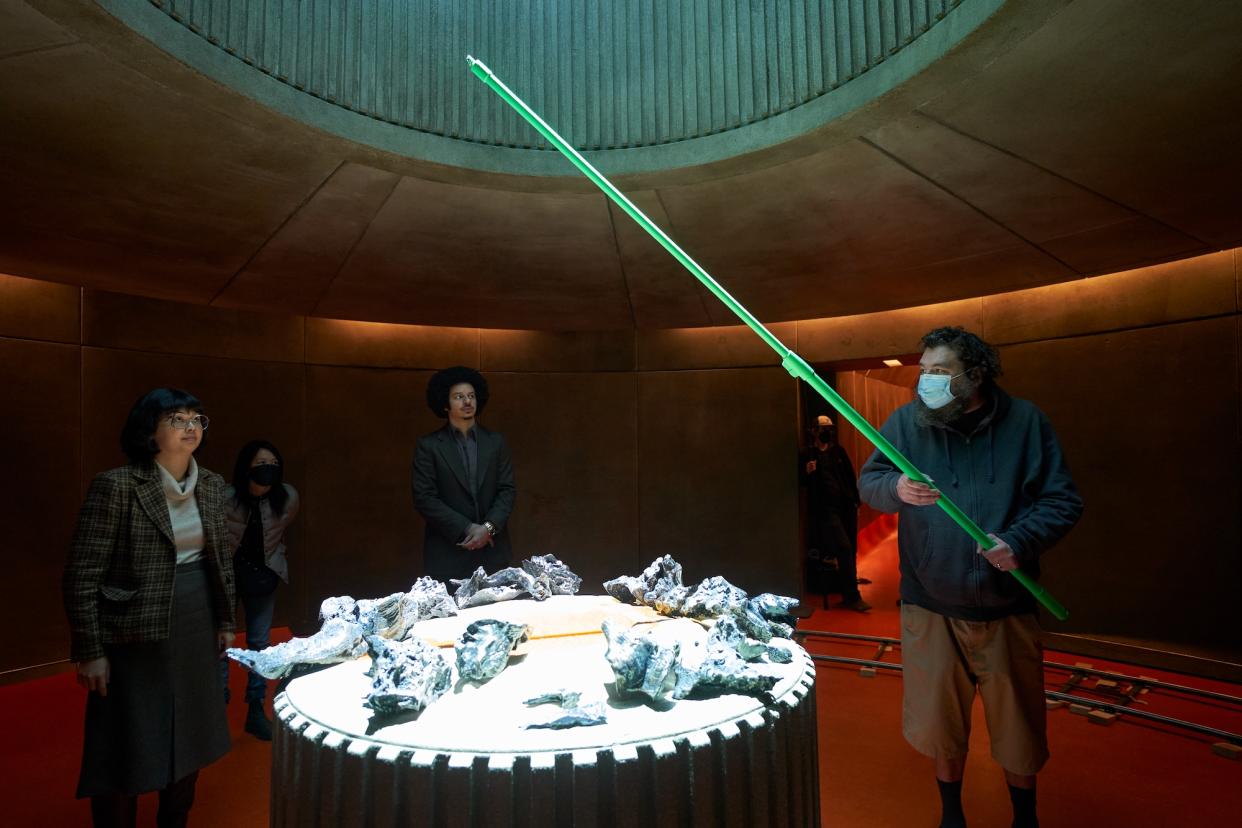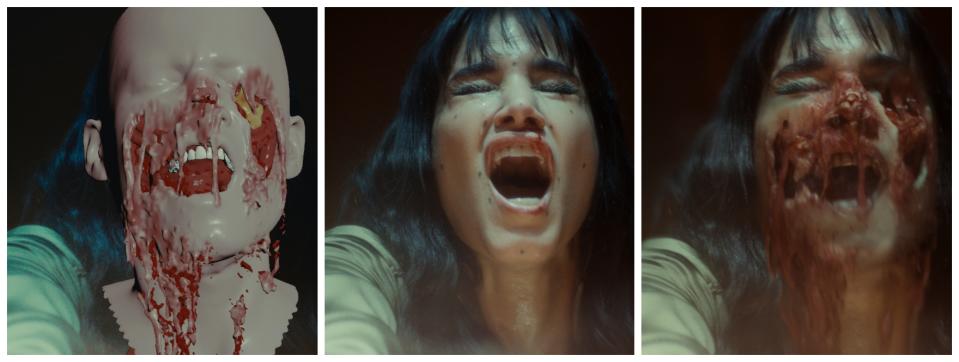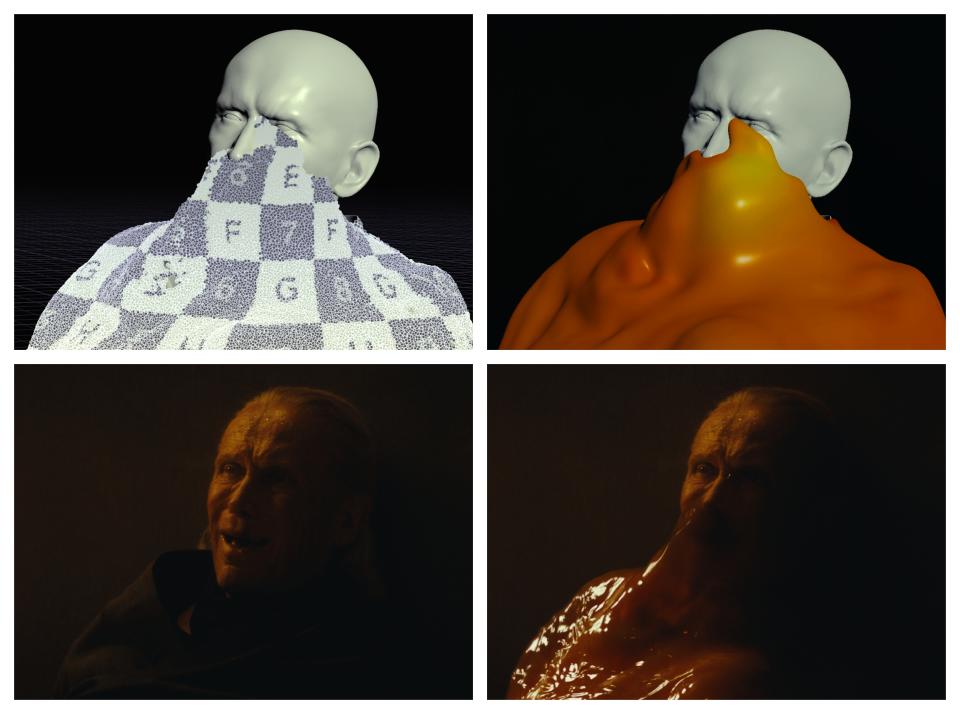How ‘The Viewing’ Pulled Off a Face-Melting Finale

- Oops!Something went wrong.Please try again later.
[Editor’s Note: The following interview contains spoilers for “Guillermo Del Toro’s Cabinet of Curiosities” Episode 7, “The Viewing.”]
If a fake exploding head is going to look believable, you need to fill it up first. Just ask Dennis Berardi, the visual effects supervisor on “Guillermo del Toro’s Cabinet of Curiosities.”
More from IndieWire
“We packed it with bits of lookalike meat and some fleshy bits. It was all stuff that wasn’t real organic. It needed to keep and fit the molds,” Berardi said.
It wasn’t the only part of this process that needed some practical glop in order to bring something terrifying to life. All of that work was in service of “The Viewing,” the Panos Cosmatos-directed episode of the Netflix horror anthology. In it, a handful of strangers are summoned by a wealthy eccentric (Peter Weller) to witness a strange addition to his collection. After a night of rare booze and Space Cocaine, the group gathers around a mysterious monolith before finding that what’s inside is more than any of them bargained for.
The wild thing about what Berardi and the “Cabinet of Curiosities” team did to make that head pop happen is that it’s just one slice of the bonkers pie that caps off “The Viewing.” Berardi said that over 300 artists across five companies (including his own, Herne Hill) contributed to the show’s efforts. The last 20 minutes of the episode is a cavalcade of strange deaths and even stranger powers.
It’s an ending that wouldn’t be nearly as effective without the steady buildup that happens before the chaos comes. (That buildup is something that Berardi has done in multiple previous del Toro collaborations, including “Crimson Peak” and “The Shape of Water.”) Creating that vibe meant using some distinct markers that lined up with the episode’s late-’70s setting.
“Panos wanted a real vintage look, right down to the lens flares. So we did a bunch of research and before we went to principal photography, we shot Panos-approved lens flares against black. We had a library of things that he could feather in, in post production,” Berardi said.
Those flares are prominent in the Obelisk Chamber, where a rogue cloud of weed smoke awakens the squishy terror locked inside it. The moment that giant rock cracks apart helps to set the tone for what comes after. Like many of those other elements, Berardi and the team achieved it by marrying the animated and the digital.
“We built a practical version of it, designed by our production designer and built beautifully as a set piece. We scanned that and did a digital version of it, too. On the set, we had a closed position with it and an open position with it, and we animated the crumbling,” Berardi said. “We tried to be authentic with laws of physics, what’s it made out of. We came up with the idea that it would be some kind of a metal alloy or a meteorite-type substance. Panos was totally into that.”

For the first three characters who meet their demises in the viewing room, Cosmatos staged each in direct, front-facing shots. Targ (Michael Therriault) melts in larger chunks, Dr. Zahra (Sofia Boutella) dissolves, and Guy (Steve Agee) has the grand distinction of being the Belloq of the group (after screaming, “It’s prooooobing meeeeee,” naturally). In addition to matching that tension of skin dissolving, it made it a little easier for Berardi to match facial composites with their practical, dummy counterparts.
“For every head, we built a low-resolution, fake, meltable head. We also scanned the actors digitally in 3D. I had the real actor’s performance. We photographed them on set, in situ, in the lighting with the anamorphic lenses, as if they were melting. The actors’ performances did most of the work. We match-moved our digital model over top of their head,” Berardi said.
An additional challenge is that the team didn’t have unlimited chances to get it right. They had two wax molds each of Therriault and Boutella’s faces, and three for Agee’s.
“On blue screen, we did time-lapse photography and melted likenesses of them with heat guns and with heaters. It took about 20 minutes of time lapse to get the head melting the way we wanted it,” Berardi said. “We’d get on calls and I’d show Panos works in progress. And we were on for hours at a time just puzzling through how to do it. He was a real joy in that way. I’d say, ‘I don’t like that piece around the lip. Can I take that away and try something else?’ And he’d say, ‘Yeah, go for it!’ It was really collaborative.”
Like the chunks falling off of faces, not all goo is made equal. When productions need something sticky for situations like this, there are standard resins that read well on screen. Cosmatos wanted to make sure that the practical orange-ish sludge for the liquified form of the creature inside the obelisk felt like it moved with “intent.”
“Geoff Hill is the practical special effects genius on this. We did all kinds of tests and we had different viscosities of different materials and he was playing with this Methocel stuff that he brought to the table. Panos thought it had an interesting quality about it. He thought maybe it was a bit thin. When you have a bucket of goo on set and you’re pouring it, you’re not getting the performative aspects,” Berardi said. “But we filmed it in various incarnations and lighting setups and did old-school gravity tricks, filming it going down and then reversing the footage. It became a physically correct reference that our animators could mimic.”

After finding the right thickness and directions to ooze, the next step was the logistics of how it all moved around Weller’s face.
“Panos very specifically choreographed that. He wanted it to go just above the nose. Guillermo wanted it coming out of the ears. So we had to really make a directable character of goo,” Berardi said.
On its face, the last shot of “The Viewing” might not seem as unsettling as watching people dissolve into a pile of viscera. But there’s something eerie about seeing the creature that was formed at the mansion escape from the city drainage system and out into a big world. That final look really took just as much detail and effort as anything else that came before it.
“That took a few months to put together. We had a man in a suit for the Blob Guy after he was formed, and then we digitally added his antenna. We shot him on a fairly small setpiece, and then we added the world around him,” Berardi said. “It started out with a couple of concept sketches for Panos. He had a very specific idea. He knew he wanted the gas station, he wanted the skyline, he wanted some storage buildings, and everything needed to look kind of derelict. We just started putting sketches in front of them and then started building into 3D.”
From a workflow perspective, Berardi said that it helped to have a director who understood the full effects process, especially when it came to add more subtle touches like the ones nestled in that last sequence.
“Panos is a digital native. I can show him a model, I can show him a pre-vis, I can show him untextured, gray-shaded, post-vis and he’s able to comment and see it for what it’s going to be in the end,” Berardi said. “He choreographed every bit of animation, right down to every car on the bridge and how everything was moving. Even the lighting. There’s this electromagnetic pulse that our creature emits where as he emerges from the tunnel on the other side. His torment really comes through and there are these concentric circles that we emit from him that fritz out all the lights.”
When it comes to “The Viewing,” most people will remember the big swings. Enjoying that spectacle came through on Berardi’s side, too.
“You have to really commit. It was just a great experience, not likely to be repeated given that it’s so out there,” Berardi said. “We saw it all the way through. The horned blob creature that first emerges, right down to the — excuse the expression — little prolapse-y thing that happens. That type of detail was just great fun. We built a wax gun and melted that. We had fake arms and melted that. How many times do you get to just melt people?”
“The Viewing,” part of “Guillermo del Toro’s Cabinet of Curiosities,” is now available to stream on Netflix.
Best of IndieWire
The Best True Crime Streaming Now, from 'Unsolved Mysteries' to 'McMillions' to 'The Staircase'
'The Last of Us' Sets Early 2023 Release at HBO: Here's Everything You Need to Know
From 'Reality Bites' to 'Fatal Attraction,' Keep Track of All the Upcoming Film-to-TV Adaptations
Sign up for Indiewire's Newsletter. For the latest news, follow us on Facebook, Twitter, and Instagram.

